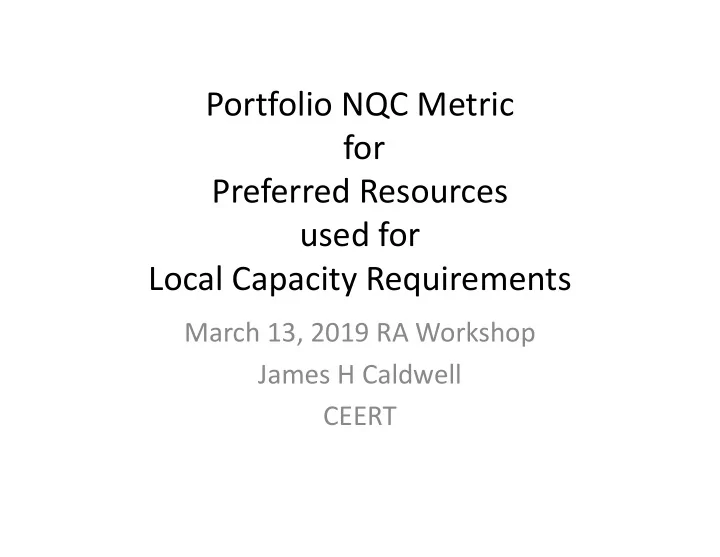

Portfolio NQC Metric for Preferred Resources used for Local Capacity Requirements March 13, 2019 RA Workshop James H Caldwell CEERT
The Issue • Unless and until preferred resources are developed to compete with existing gas for meeting most LCR requirements, today’s local RA woes will continue: – Lack of Revenue Adequacy for needed thermal fleet in competitive areas. – Market power of thermal fleet in non-competitive areas. – Excess GHG emissions, renewable curtailment and related market inefficiencies. • Multi-year LSE obligation is not an answer as RPS doubles over the planning horizon.
Preferred Resource LCR Today (1) • Dominated by stand alone 4 hr storage. – Competitive with long run cost of service of existing gas (e.g., South Bay/Moss Landing) but not LCR pricing in competitive areas. – Storage duration too short in many cases. – Storage duration too long in many cases. – State of charge management requirements not clear. • Current metrics for other preferred resources simply do not apply to LCR use case: – Solar PV – system level ELCC not applicable during contingency event defining LCR need. – “Slow response” DR – zero NQC not applicable if paired with storage. – Programmatic EE and DR cost effectiveness metrics and M&E protocols do not apply.
Preferred Resource LCR Today (2) • Assumption that individual elements of a portfolio are independent and thus NQCs are additive does not apply. • Because many preferred resources are use limited, conventional NQC alone is not sufficient to ensure reliability. • ISO dispatch software cannot automatically dispatch “partial solutions” or most hybrids during contingency conditions.
SCE Santa Clara Sub-area RFP 130 MW/645 MWH Need
Portfolio NQC Proposal(1) • Planning: – CPUC to formally adopt recent CAISO process change documenting peak load, load shape, and on peak energy for calculating LCR need. – A “Portfolio NQC” is calculated for any particular preferred resource portfolio proposed by an LSE with either a LCR obligation or CAM allocation for LCR. – Calculation to be an ELCC analysis of adding the proposed resource portfolio within the load pocket to the LCR need case adopted by the CPUC. – The Portfolio NQC (equal to ELCC of the portfolio) applies only to the full portfolio for LCR purposes. For now, any system or flexible NQC applies to individual portfolio elements calculated by conventional means.
Portfolio NQC Proposal (2) • Procurement/showing: – The sponsoring LSE would procure/construct the portfolio, perform an acceptance test, and show it to fill its allocated LCR need and/or CAM obligation up to the Portfolio NQC value. – Any “surplus” NQC could be sold to other LSEs in the load pocket. – Any individual portfolio element with a NQC calculated conventionally could also be used to fill a system or flexible RA allocation/CAM allocation.
Portfolio NQC Proposal (3) • Commitment: – The dispatchable/curtailable portion of the portfolio or any fraction thereof not already committed through normal bidding/load modification would be committed in DA RUC (or successor process) any time net load in the load pocket was forecast to be above transmission capacity under N-1- 1 constrained conditions. – The SC for the sponsoring LSE is responsible to pre-notify any DR element and bring any battery storage to appropriate SOC prior to the forecasted need hour. – If the consequence of the contingency event is voltage collapse, the appropriate amount of the portfolio would be committed as spin with the rest committed as 20 min operating reserves.
Portfolio NQC Proposal (4) • Dispatch: – All dispatch/spin call instructions issued to the SC post contingency. The SC is responsible for “dispatch” of individual elements of the portfolio. – Any curtailment of solar or other DG previously initiated for system level reasons lifted simultaneously with the portfolio dispatch instructions. – The SC remains responsible for following dispatch instructions/ensuring resource adequacy in the load pocket for the duration of the event as long as load w/o the dispatched portion of the portfolio stays above the transmission limit.
Portfolio NQC Proposal (5) • Settlement: – CAISO would settle with the SC at the portfolio level at applicable spin, 20 min operating reserve, and energy prices. – The SC/LSE is responsible for distributing CAISO market revenues to individual portfolio elements. – The LSE is responsible for payment of any reservation fees/forward capacity payments outside of CAISO market to portfolio elements. – The LSE is obligated to provide quantity/cost data to the Energy Division per existing protocols for RA reporting purposes.
Recommend
More recommend